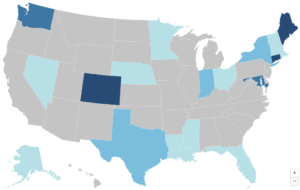
As hospitals and well being techniques increase their possession and management of ambulatory care practices and doctor workplaces, they continuously cost new facility charges for routine medical companies delivered in outpatient settings. These further payments drive up premiums and well being expenditures for customers, employers, and, finally, taxpayers. Shoppers additionally face rising monetary publicity to those facility fees as insurance coverage deductibles improve and payers apply profit designs that improve sufferers’ publicity to out-of-pocket prices, significantly in hospital outpatient settings. With assist from and dealing in partnership with West Well being, consultants at Georgetown College’s Middle on Well being Insurance coverage Reforms (CHIR) have recognized and categorised state legal guidelines regulating outpatient facility payment billing nationwide and have simply launched our findings in a set of maps obtainable right here.
Twenty States Have Adopted At Least One Reform Technique as of July 1, 2024
Twenty states, stretching throughout the nation and representing a range of political orientations, have adopted no less than one reform technique as of July 1, 2024. These reforms embody:
Whereas their alternative of instrument varies, the broad array of states taking motion is per survey knowledge exhibiting widespread, bipartisan assist for outpatient facility payment regulation.
Connecticut, Colorado, Maine, and Indiana Stay on the Forefront of Reforms
CHIR and West Well being beforehand dug into how 11 research states have been approaching outpatient facility payment reforms. That effort recognized Connecticut, Colorado, Maine, and Indiana as states on the forefront of regulation outpatient facility payment billing. Our new nationwide evaluation confirms that these states have enacted probably the most complete reforms up to now.
Connecticut, Maine, and Indiana every have prohibited outpatient facility payment billing for routine medical companies in sure hospital-owned settings. Colorado was the primary state within the nation to require industrial claims varieties to specify the precise workplace the place care was delivered, with Maine, amongst different states, following in its footsteps extra just lately. All 4 states have additionally enacted between one and three different kinds of reforms, together with public reporting or research necessities in all 4 states, shopper notification necessities in three, and out-of-pocket price protections in two.
Incrementalism Is the Identify of the Sport
As the gathering of legal guidelines within the above flagship states exhibit, the varied methods for reforming outpatient facility payment billing aren’t mutually unique. However states usually deal with reform in an incremental style. The brand new maps reveal that almost all states have enacted just one kind of reform for outpatient facility payment billing and most of those efforts are comparatively modest: shopper notification necessities, research or reporting necessities, or prohibitions on facility charges restricted to telehealth companies. And no state within the nation has adopted site-neutral reforms within the industrial medical insurance market, which might deal with the underlying incentives driving the expansion of facility charges.
Nonetheless Connecticut—the place lawmakers have regularly expanded their reforms over the previous decade, together with within the most up-to-date legislative session—demonstrates that incremental steps can remodel a state right into a nationwide chief.
Momentum Is Constructing, Regardless of Sturdy Trade Opposition
A number of states, like Connecticut, Maine, and New Hampshire, started addressing this challenge ten or extra years in the past, however most states with facility payment legal guidelines in impact enacted or amended their legal guidelines since 2021. Certainly, seven states handed facility payment reform laws prior to now 18 months alone. And extra motion seems on the horizon after an lively 2024 legislative session, with a number of states launching job forces to check facility charges and potential reforms.
As occurred with shock billing reforms, state exercise could properly pave the best way for federal reforms. Even in right now’s polarized political ambiance, there’s bipartisan curiosity in Congress to enact “sincere billing” necessities, facility payment prohibitions, and site-neutral cost reforms. These efforts are strongly supported by all kinds of stakeholder teams itching for motion. CHIR will proceed to observe and periodically replace our maps to mirror ongoing developments on this space. Policymakers and advocates contemplating facility payment reforms are inspired to contact CHIR consultants for technical help at [email protected].

